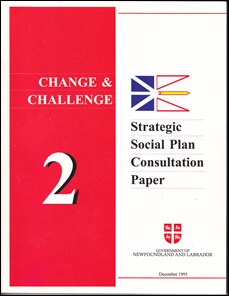 This Strategic Social Plan Consultation Paper initiates the final phase of an intensive Provincial planning process which began more than six years ago. When this Government took office in 1989, we made a commitment to the people of Newfoundland and Labrador to review all economic and social programs and mandates and to develop strategic plans to carry the Province through the turbulent changes of the 1990s into a stronger future in the 21st century.
This Strategic Social Plan Consultation Paper initiates the final phase of an intensive Provincial planning process which began more than six years ago. When this Government took office in 1989, we made a commitment to the people of Newfoundland and Labrador to review all economic and social programs and mandates and to develop strategic plans to carry the Province through the turbulent changes of the 1990s into a stronger future in the 21st century.
In the fall of 1990, Government began the first phase of this planning process through a review of economy's strengths and weaknesses, examination of the activities and policies of economic departments and agencies, and the subsequent development of a public consultation paper to provide an opportunity for the people of the Province to have direct input into the vision, guiding principles, and actions that eventually became the Strategic Economic Plan (SEP).
When the SEP was released in June 1992, however, we stressed that it was only half of the planning cess. Economic issues cannot be examined or addressed in isolation from social issues and realities, and it was imperative to move on to the second phase of our strategic planning: the development of a Strategic Social Plan. A Social Planning Group (SPG) of senior officials was established, and on March 4, 1993, the Throne Speech in the House of Assembly reaffirmed Government's commitment to the development of a Strategic Social Plan as the essential and equal partner to the SEP.
During the past three years, the SPG faced many challenges in their task of researching global trends reviewing programs and policies. Unlike economic planning activity, strategic social planning models were virtually unknown, and the Group were for the most part breaking new ground. In addition, they were caught in a maelstrom of social change and reform at both the Provincial and Federal levels, and were obliged to constantly revise data and projections to keep pace with national social reforms and in funding.
Nevertheless, the work of the SPG progressed to the point where relatively stable data could be provided to Cabinet and a consultation paper could be developed. This document is not a final Strategic Social Plan but it is a clear statement of the direction in which Government intends to proceed in terms of providing essential services for the social well-being of our citizens in as effective and efficient as possible. We now invite comment and suggestions from the people of Newfoundland and through the extensive public consultation process which will precede the development of the Strategic Social Plan.
I encourage all citizens, and especially organizations concerned with various social issues, to examine this paper thoroughly and to give serious consideration to the social challenges that are outlined and to the strategies and actions that are proposed. I look forward to receiving the thoughtful views of people throughout the Province as we continue the process of planning our social order for generations to come.
[original signed by]
Clyde K. Wells
-srbp-
To come: “Introduction and Background”
- Introduction
- Social profile
- Demographic Change and Challenge
- Living in a Different World
- Realities
- Principles
- Vision
Explanatory Note: The 159 page Strategic Social Plan [SSP] consultation paper is being presented in a series of instalments. A companion to the 1992 Strategic Economic Plan, it lays out both a clear statement of where the province was in 1995, the challenges to be faced in the future and policies to deal with those challenges successfully.
Approved by cabinet for release in December 1995, the 1,000 copies of the consultation document were ordered destroyed by the Tobin administration in 1996. Only a handful of copies survived.
The planned consultation never took place. Instead, and while something subsequently emerged which was labelled a Strategic Social Plan, the new Tobin administration went down an entirely different road from the one envisaged in the 1995 consultation paper.
Some specific initiatives from the 1995 document did make it into action. Others did not. Unfortunately, the fundamental approach – the integrated concept – that underpinned the strategy went out the window with the change of administration in January 1996.
It never returned.
The current state of the provincial government – unsustainable levels of public spending in an increasingly fragile economy – are a direct result.
In a province facing an uncertain future, where political leaders are devoid of ideas, let alone sustainable or new ones, the 1995 Strategic Social Plan remains relevant.